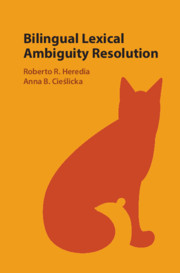Book contents
- Bilingual Lexical Ambiguity Resolution
- Bilingual Lexical Ambiguity Resolution
- Copyright page
- Dedication
- Contents
- Figures
- Tables
- Contributors
- Preface
- Acknowledgments
- Part I Theoretical and Methodological Considerations
- Part II Bilingual Lexical Processing
- Part III Bilingual Sentence Processing
- 7 Bilingual Lexical Access and Reading
- 8 Online Ambiguity Resolution in Bilingual Lexical Access
- Part IV Neuroscience of Bilingual Lexical Access
- Author Index
- Subject Index
- References
8 - Online Ambiguity Resolution in Bilingual Lexical Access
from Part III - Bilingual Sentence Processing
Published online by Cambridge University Press: 24 December 2019
- Bilingual Lexical Ambiguity Resolution
- Bilingual Lexical Ambiguity Resolution
- Copyright page
- Dedication
- Contents
- Figures
- Tables
- Contributors
- Preface
- Acknowledgments
- Part I Theoretical and Methodological Considerations
- Part II Bilingual Lexical Processing
- Part III Bilingual Sentence Processing
- 7 Bilingual Lexical Access and Reading
- 8 Online Ambiguity Resolution in Bilingual Lexical Access
- Part IV Neuroscience of Bilingual Lexical Access
- Author Index
- Subject Index
- References
Summary
This chapter reports on three experiments using the cross-modal lexical priming paradigm to explore whether interlingual homographs (i.e., words with competing semantic and overlapping orthographic representations) are activated selectively or nonselectively. The literature is somewhat controversial when it comes to the question of how bilinguals process ambiguous language. While the majority of studies suggest language nonselectivity, some research seems to indicate selective bilingual lexical access depending on the user’s linguistic needs and demands. In Experiment 1, which serves as a baseline, Spanish-English bilinguals listened to sentences in which a critical prime (e.g., trial) was associated with the English meaning of a homograph target (cases). In Experiment 2, participants were presented with homograph-translation primes (e.g., the stimulus married is presented before cases). Experiment 3, aside from the homograph-translation priming from Experiment 2, included a Spanish language mode induction variable presented at the beginning of the experiment. Results point to the effects of proficiency and priming in modulating language coactivation.
Keywords
- Type
- Chapter
- Information
- Bilingual Lexical Ambiguity Resolution , pp. 184 - 228Publisher: Cambridge University PressPrint publication year: 2020
References
Further Reading
References
- 1
- Cited by

